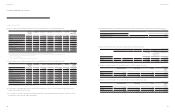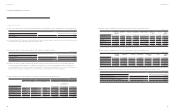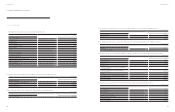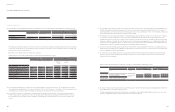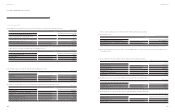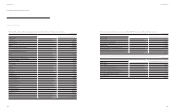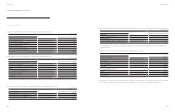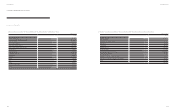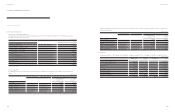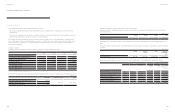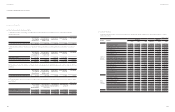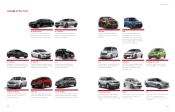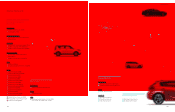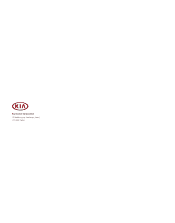Kia 2014 Annual Report Download - page 58
Download and view the complete annual report
Please find page 58 of the 2014 Kia annual report below. You can navigate through the pages in the report by either clicking on the pages listed below, or by using the keyword search tool below to find specific information within the annual report.
Notes to the Consolidated
Financial Statements
KIA MOTORS CORPORATION AND SUBSIDIARIES
December 31, 2014 and 2013
30. Finance Risk Management
The Company’s activities are exposed to a variety of nancial risks: credit risk, liquidity risk and market risk (comprised of foreign exchange risk
and interest rate risk). The treasury department monitors and manages the nancial risk arising from the Company’s underlying operations in
accordance with the risk management policies and procedures authorized by the board of directors.
(a) Credit risk
Credit risk is the risk of nancial loss to the Company if a customer or counterparty to a nancial instrument fails to meet its contractual
obligations. The Company has transacted with customers before evaluating on their credit rating and have their collaterals to control customers
on default.
(b) Liquidity risk
Liquidity risk is the risk that the Company will encounter difculty in meeting the obligations associated with its nancial liabilities that are settled
by delivering cash or another nancial asset. Management believes the Company maintains adequate sources of liquidity to settle short-term
nancial liabilities. In addition, based on periodic analysis of expected cash outows, the Company also considers other alternatives, including
seeking additional external nancing or disposition of nancial instruments for investment purpose, to mitigate liquidity risk.
(c) Market risk
Market risk is the risk of uctuations in fair value of nancial instrument and future cash ow by changes of market price. The purpose for
managing market price is to optimize prots, while manage and control on exposure to market risk within acceptable limits.
(i) Foreign exchange risk
The Company is exposed to foreign exchange risk arising from high proportion of export in sales amount, which is denominated in foreign
currencies. The Company’s primary exposure is to the US dollar and Euro and the Company manages to minimize nancial risk on uctuations
in foreign exchange in order to stabilize operating activities. The Company consistently evaluates on various foreign exchange risk according to
the Company’s own guideline for foreign exchange and transaction policy. If necessarily, the Company may enter into foreign currency forwards
contracts to hedge its foreign currency risk and strictly limit on speculative transaction.
(ii) Interest rate risk
The Company’s asset and liability is exposed to interest rate risk on deposits and loans. In order to minimize actual Interest cost, the Company
continuously monitors current status of market interest rate, make a prediction on market data and reviews on method for borrowing and
joining nancial instruments on deposit. Also, the Company’s management monitors the level of interest rates and maintains the balance of
borrowings at variable rates and xed rates.
(d) Management of capital risk
The fundamental goal of capital management is to maintain on nancial structure. As for this to be maintained, the Company use debt ratio as
indicator of capital management. The debt ratio is calculated as total liability divided by total equity.
(a) Details of cash ows from operating for the years ended December 31, 2014 and 2013 are summarized as follows:
2014 2013
Changes in assets and liabilities:
Accounts and notes receivable - trade ₩ (356,238) (273,770)
Accounts and notes receivable - other (28,772) 22,129
Inventories (1,814,936) (80,758)
Accounts and notes payable - trade 479,929 189,659
Advances received (58,353) 9,519
Accounts and notes payable - other 260,469 119,992
Accrued expenses 239,186 204,951
Payment of retirement benets (31,935) (14,947)
Change of net dened benet liability (256,569) (10,844)
Payment of warranty expenses (898,615) (835,862)
Others (88,091) (41,105)
(2,553,925) (711,036)
Cash generated from operations ₩ 2,679,387 5,051,324
(b) Signicant non-cash investing and nancing activities for the year ended December 31, 2014 are as follows:
2014 2013
Change in advances received in connection to disposal of property, plant and
equipment ₩ -(69,937)
Change in accounts and notes receivable - other in connection to disposal of property,
plant and equipment (16,218) -
Change in accounts and notes payable - other in connection to acquisition of property,
plant and equipment (45,808) (62,599)
Change in accounts and notes payable - other in connection to acquisition of intangible assets (21,282) -
Reclassication from investments in available-for-sale nancial assets to associates 319,830 372,847
(KRW in millions)
(KRW in millions)
112 113
Annual Report 2014Financial Review


